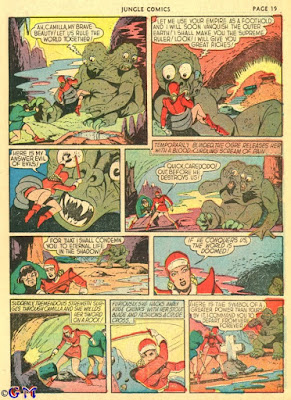In literature the name "Camilla" first appears in Virgil's Aeneid, written between 29 and 19 BC. There's no evidence that any character with that name appeared in earlier Roman myth, though because she was an athletic huntress-type, she might have originally been either a servant of the Hunt-Goddess Diana/Artemis, or even a mortal version of Diana herself.
In JUNGLE COMICS #1 (1940), an artist billed CAW (identified on GCD as Chuck Winter, best known for co-creating DC's "Liberty Belle") did a thinly disguised ripoff of Rider Haggard's novel SHE. An explorer named Jon finds the requisite lost city of white people in the African jungle, all descended from Vikings. This "Lost Empire" is ruled by a queen named Camilla, who stays immortal with the help of a sulphur spring. She tries to make Jon her consort, but he resists, and ends up destroying her Viking city. With the destruction of her spring, Queen Camilla ages and dies.
In the very next issue, Winter virtually reprised the same story. An explorer with a different name encountered a queen with the same name, but one who ruled over a people descended from the Mongols of Genghis Khan. (Note that despite her supposed Mongol descent Camilla II looks like any old blonde flapper of the time.) The most interesting near-mythic aspect of this story is that despite originally possessing no science themselves, the Mongols somehow acquire super-science over the centuries thanks to the "raw materials" in the area, including some mineral that gives off "flexodium, a radium ray unknown to the outer world." Camilla II's city is also destroyed by her unwilling consort but she refuses to be rescued, walking back into her burning city, never to be seen again. The story is mostly interesting as a predecessor to the 2018 BLACK PANTHER film. In that narrative, African natives acquire super-science purely by their access to a magical mineral, not because they have any contact with advanced technology outside their world (in contradistinction to the way Wakanda was portrayed in its first FANTASTIC FOUR storyline).
Apparently, having tried on two versions of the same Haggardian idea, Winter decided he liked the first one better, so Camilla I, despite having already died, gets better, as does her previously destroyed Lost Empire-city. She has another encounter with the white explorer in JUNGLE COMICS #3, and this time he escapes without blowing everything up. Then in issue #4, it appears that Winter decided to give his evil queen a moral makeover. Camilla I gets tossed out of her own lost city, wanders around a while, and runs into Jon and his girlfriend Ruth. She suddenly reveals magic powers, turning Jon into a block of ice. Yet once Jon goes back to normal, he and Ruth help Camilla I regain her throne, and she swears to be a good queen from then on. By issue #6 Winter was gone, replaced by Bob Powell, and Camilla suddenly develops swordfighting skills.
Camilla I's first brush with mythic complexity occurs when she decides in JUNGLE COMICS #7 to challenge the powers of "Hades itself." (By now, the idea of Camilla I's having been a Viking has been utterly forgotten.) She takes with her a hunchback named Caredodo, introduced in the previous issue, and the two of them face down Mephistopheles, who looks like every standard devil ever created, and Satan, who for a change has a more Dante-esque look, being a two-headed green monster. Camilla I conquers Satan with the use of a Christian cross, and a visiting angel descends to grant the courageous woman a wish. (Maybe he thought he was a genie?) She wishes for Caredodo to be transformed into a handsome cavalier, whom she named "Sir Champion," which makes one wonder if her wish was more for her own amatory benefit.
However, Camilla and Champion only enjoyed about twenty more adventures-- none of which were particularly romantic-- before her status as Queen of the Lost Empire dwindled away. In JUNGLE COMICS #27, Camilla makes a brief reference to her former status as the queen of a city of lost Vikings before she dons a zebra-skin and becomes just another Sheena-like jungle crusader. I haven't read all of these, but I doubt there's anything close to symbolic complexity therein.








No comments:
Post a Comment